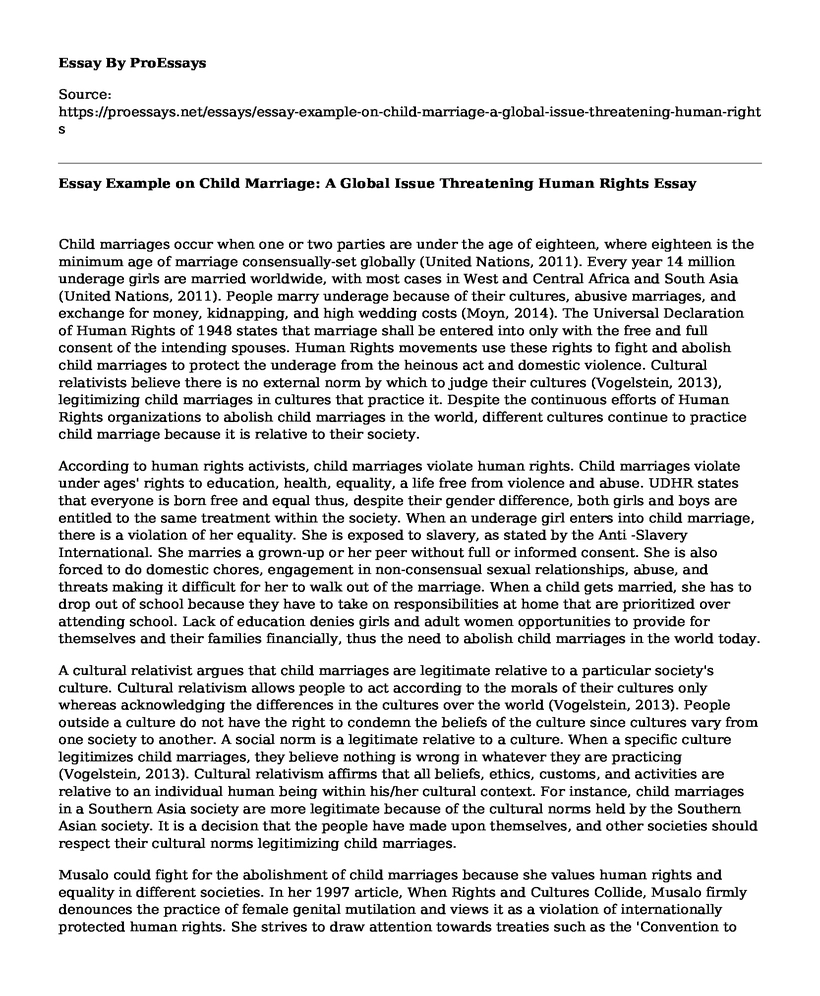Child marriages occur when one or two parties are under the age of eighteen, where eighteen is the minimum age of marriage consensually-set globally (United Nations, 2011). Every year 14 million underage girls are married worldwide, with most cases in West and Central Africa and South Asia (United Nations, 2011). People marry underage because of their cultures, abusive marriages, and exchange for money, kidnapping, and high wedding costs (Moyn, 2014). The Universal Declaration of Human Rights of 1948 states that marriage shall be entered into only with the free and full consent of the intending spouses. Human Rights movements use these rights to fight and abolish child marriages to protect the underage from the heinous act and domestic violence. Cultural relativists believe there is no external norm by which to judge their cultures (Vogelstein, 2013), legitimizing child marriages in cultures that practice it. Despite the continuous efforts of Human Rights organizations to abolish child marriages in the world, different cultures continue to practice child marriage because it is relative to their society.
According to human rights activists, child marriages violate human rights. Child marriages violate under ages' rights to education, health, equality, a life free from violence and abuse. UDHR states that everyone is born free and equal thus, despite their gender difference, both girls and boys are entitled to the same treatment within the society. When an underage girl enters into child marriage, there is a violation of her equality. She is exposed to slavery, as stated by the Anti -Slavery International. She marries a grown-up or her peer without full or informed consent. She is also forced to do domestic chores, engagement in non-consensual sexual relationships, abuse, and threats making it difficult for her to walk out of the marriage. When a child gets married, she has to drop out of school because they have to take on responsibilities at home that are prioritized over attending school. Lack of education denies girls and adult women opportunities to provide for themselves and their families financially, thus the need to abolish child marriages in the world today.
A cultural relativist argues that child marriages are legitimate relative to a particular society's culture. Cultural relativism allows people to act according to the morals of their cultures only whereas acknowledging the differences in the cultures over the world (Vogelstein, 2013). People outside a culture do not have the right to condemn the beliefs of the culture since cultures vary from one society to another. A social norm is a legitimate relative to a culture. When a specific culture legitimizes child marriages, they believe nothing is wrong in whatever they are practicing (Vogelstein, 2013). Cultural relativism affirms that all beliefs, ethics, customs, and activities are relative to an individual human being within his/her cultural context. For instance, child marriages in a Southern Asia society are more legitimate because of the cultural norms held by the Southern Asian society. It is a decision that the people have made upon themselves, and other societies should respect their cultural norms legitimizing child marriages.
Musalo could fight for the abolishment of child marriages because she values human rights and equality in different societies. In her 1997 article, When Rights and Cultures Collide, Musalo firmly denounces the practice of female genital mutilation and views it as a violation of internationally protected human rights. She strives to draw attention towards treaties such as the 'Convention to Eliminate Discrimination against Women' which intensely forbids distinctions made on gender basis. Musalo (1997) further argues about the many cultures that deny the equal rights of women and girls in society. Further in the article, Musalo (1997) stresses on the prominence of contemporary universal human rights regulation and the protection of basic human rights. The ideas from the article justify that Musalo advocates for universal human rights, which seek the abolishment of child marriages, which some cultures legitimize.
References
Moyn, S. (2014). The Universal Declaration of Human Rights of 1948 in the history of cosmopolitanism. Critical Inquiry, 40(4), 365-384.
Musalo, K. (1997). When Rights and Cultures Collide. Issues in Ethics, 8(3), 2-4.
United Nations. (2011). Population Facts: World Marriage Patterns.
Vogelstein, R. B. (2013). Ending child marriage: How elevating the status of girls advances US foreign policy objectives. Council on Foreign Relations.
Cite this page
Essay Example on Child Marriage: A Global Issue Threatening Human Rights. (2023, May 08). Retrieved from https://proessays.net/essays/essay-example-on-child-marriage-a-global-issue-threatening-human-rights
If you are the original author of this essay and no longer wish to have it published on the ProEssays website, please click below to request its removal:
- Utilitarianism and Illegal Abortions Essay Example
- Essay Sample on Israel's Criminal Justice System
- Community Needs Assessment Paper Example
- Essay Sample on Dealing With Work-Style Disputes: How to Avoid Conflict & Improve Communication
- Generalist Social Work: Strengthening Communities and Enhancing Justice - Essay Sample
- Essay on Women Pivotal in Civil War: Volunteering, Nursing, Advocating, Spying, and More
- Essay Example on Corporate Social Responsibility: Enhancing Brand Value & Improving Society







